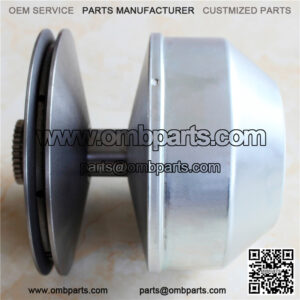Golf Cart Clutches
The drive (or primary) clutch attaches to the engine crankshaft. At rest, the drive clutch faces (sheaves) are separated by the wide drive belt. The driven (or secondary) clutch bolts onto the input shaft of the differential. The driven clutch sheaves are spring loaded together and the belt, at rest, rides up at the outer edge. Both golf cart clutches look similar to a large pulley but each clutch has a sliding sheave that moves in & out along a central shaft as the clutch spins. The other sheave is fixed to either the crankshaft or the differential input shaft and it does not slide, it just spins.
Golf cart clutches, working together, provide a smooth start up and take off, and smooth acceleration and deceleration. If the start up is jerky, or if there is poor speed transition from level ground to climbing a hill, or if the car has erratic (fast then slow then fast again) high end speed, bad golf cart clutches may be indicated.
The hill climbing ability of a golf cart depends a lot on how well the drive and the driven clutches transition from their top speed ‘cruising’ position to their low speed ‘pulling’ position. These two golf cart clutches, or pulleys, must work together as a single unit and that requires both to be in good condition. What follows is my best effort to describe the interaction of the clutches with the engine and the differential (rear end) to create a smooth transition from stop to top speed and back to stop again with all speeds in between.
Drive
The drive, or primary, clutch is found on the crankshaft of the engine. A thick, heavy ‘drive’ belt is wrapped around it and links it to the driven clutch, on the differential. At rest, the drive clutch sheaves (or pulley halves) are separated enough that the drive belt rests in between the sheaves & against the center shaft of this clutch. As the engine spins, internal flyweights cause one drive clutch sheave (pulley half) to slide in along its main shaft toward the other sheave, which is fixed to the engine crankshaft.
As the engine speed changes, the flyweight action forces the drive belt to move up or down the clutch faces thus changing the pulling ratio of the clutch (which affects the pulling power of the engine). When the belt is down near the center shaft of the drive clutch the pulling ratio is about a 3:1 advantage for the engine. As the belt rides up toward the outer edge of the drive clutch the car is near the top ‘cruising’ speed (about a 1:1 pulling ratio).
Driven
The other half of this system is the driven, or secondary, clutch. At rest the driven clutch sheaves are spring loaded together, so the belt sits up at the outer edge of this clutch, NOT down toward the center shaft. It, too, spins around and has a sheave that sides in & out along it’s main shaft but this clutch has no flyweights. It works only when acted upon by the force of the drive belt.
As the engine spins, thus forcing the belt to ride higher on the drive clutch, the belt, in turn, forces the driven clutch sheaves to separate, allowing the belt to ride closer to the center shaft of the driven unit. In other words, as the drive clutch sheaves come together the belt causes the driven clutch sheaves to separate. This give and take between the golf cart clutches, via the belt action, is what gives the cart variable speeds…an automatic transmission, so to speak.
Belt Operation
As the drive belt forces the driven clutch sheaves to separate, the PULLING ratio of the engine changes from maximum (when the belt is at the outer edge of the driven unit) to minimum PULLING power, or top cruising speed (when the sheaves are completely apart).
Picture this: As the engine spins faster, internal flyweights in the drive clutch cause the sliding sheave to move in toward the fixed sheave. This squeezes the drive belt forcing it to ride up the beveled faces of the drive clutch. The normally loose drive belt gets tighter and this forces the driven clutch sheaves to separate thus creating movement of the car. The higher the belt rides on the drive clutch, the faster the car will go, until the top of the belt reaches the outer edge. Both golf cart clutches must have their sliding sheaves move in and out smoothly along their respective shafts. If this transition is not smooth and seamless then trouble is at hand.
If the car runs fine on level ground and then slows dramatically as it starts up a hill, comes to a near stop, and then suddenly begins to pull again, then a drive clutch rebuild or replacement might be indicated. The sequence described above is a classic symptom of a drive clutch gone bad. It cannot smoothly shift, or transition, from a higher to a lower ‘gear’. The internal flyweights, pivot pins & bushings are all worn to the point that replacement is required. This doesn’t get better with time. Eventually the drive clutch will lockup in the high speed position and the car will begin to jerk as it cranks and starts.
Driven Issues
The driven clutch can misbehave in many ways. It has one main shaft and the sliding sheave has an internal bushing that will wear, and it has several inclined metal ramps (usually aluminum) with small plastic buttons that protect the ramps as they glide against one another. Frequently the buttons go away & the metal ramps start to rub against each other. It’s not long before the speed transition becomes very poor.
Yamaha Tip: You can easily see these ramps by looking just inboard of the large driven clutch pulleys where the unit slims down to a smaller diameter nearer to the differential housing. You will see a central spring enclosed on each end by a funky looking cup with 3 pyramid shaped cones on the sides each cup. These cones are the ramps I mentioned above and they interlace and interface with each other. On the outer tip of each cone SHOULD be a small flat button (2 cycle cars have 6 buttons total, 4 cycles have 3. Originally they were white). The buttons prevent the metal ramps from rubbing against one another as they move in and out.
Buttons
OK picture this: The engine revs up and the drive belt starts to ride down into the pulley faces of the driven clutch forcing them to separate. The inboard pulley half begins to slide along the main shaft compressing the spring and bringing the funky cup ends and their respective ramps up against one another. The small plastic buttons actually come between the metal ramps to protect them and allow them to smoothly glide in & out against each other. Sometimes one or two buttons may be gone and the whole thing still works pretty well, but not for long! When all the buttons are missing the metal ramps quickly wear away and soon the clutch can no longer function properly. Level running is fair but heavy loads and hill climbs are out of the question…won’t pull!
Driven Spring
While we are on the Yamaha driven clutch another failure that occurs is almost impossible to detect but it also impairs the hill pulling power of the car. Keep looking inboard to where the funky spring cap butts up against the differential housing. The spring cap doesn’t actually touch the differential case. There should be enough of a gap that you can insert your finger between the spring cap end and the diff case. (Please don’t try this with the clutch spinning. Car stopped. Key off.)
What happens is that a small, difficult to see, snap ring that keeps proper tension on the main spring, fails. The snap ring comes out of its keeper groove machined into the differential input shaft, and this allows the main spring to lose much of its tension. This adversely affects the pulling power of the drive train. Once the snap ring goes south, a new one will NOT stay in its groove. A special collar can be purchased that replaces the snap ring and fixes everything back to normal. The alternative is to dissemble the differential, replace the input shaft and reinstall everything back into the car. UGLY! You will need to dissemble the driven clutch to install this special collar but it is much preferable to the alternative.

